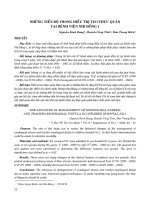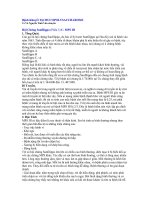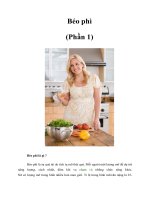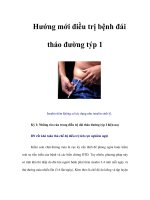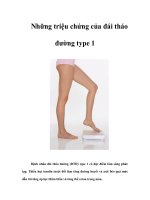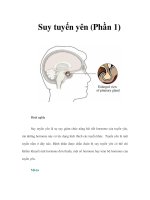Ethephon and Jackfruit (1) ppt
Bạn đang xem bản rút gọn của tài liệu. Xem và tải ngay bản đầy đủ của tài liệu tại đây (114.55 KB, 10 trang )
Ethephon and Jackfruit (1)
Introduction - Regulatory Aspects
All pesticides sold or distributed in the United States (US) must be
registered with the EPA (US Environmental Protection Agency) for the
intended uses and must have safety data to show that they can be used
without posing unreasonable risks to humans and the environment. Ethephon
(2-chloroethylphosphonic acid) is classified as an organophosphate
pesticide. It is registered with the EPA since 1973 as a plant growth
regulator used to promote fruit repening and flower induction and has
approved applications in food, feed and nonfood crops, greenhouse nursery,
outdoor residential ornamental plants, and mostly in cotton.
Toxicology – Summary
As an organophosphate, Ethephon is expected to inhibit plasma
cholisterase in humans. Indeed, in studies involving laboratory animals or
humans, Ethephon inhibits primarily plasma butyrylcholinesterase. The
results of those studies also suggest that Ethephon is a very weak inhibitor of
cholinesterase.
Ethephon is irritant to the skin or the eyes but it is not a skin
sensitizer. Ethephon is not a carcinogen and is classified by IARC
(International Agency for Research on Cancer – a WHO organization) as
Group D (not carcinogenic to humans). Ethephon is not a developmental
toxicant and does not appear to induce adverse reproductive effects.
Although Ethephon is an organophosphate, it does not appear to cause
delayed neurotoxicity in laboratory animals. In 2000, the World Health
Organization has classified Ethephon as “unlikely to present an acute hazard
in normal use”
Human Exposure
Humans are exposed to Ethephon through the diet or via occupational
exposures (handlers, pesticide sprayers, etc.). Tolerances or maximum
residue limits have been established for Ethephon in many raw agricultural
commodities, processed foods and feeds. Several International Codex
Maximum Residue Limits (MRLs) have been established for Ethephon in
apples, strawberries, cherries, pineapples tomatoes and walnuts.
Human Risk Assessment
Ethephon has the potential to cause severe skin and eye irritation upon
contact. As an organophosphate, it has the potential to cause cholinesterase
inhibition leading to adverse neurotoxic effects. Consequently, infants
encounter the greatest exposure and risk as a result of ingesting Ethephon
from foods and crops.
Ecological Effects Risk Assessment
Ethephon is expected to have minimal effects on birds and mammals
as well as on fish, freshwater invertebrates, and marine and estuarine
organisms.
Dietary Risk Assessment
The Joint Meeting on Pesticide Residues (JMPR; an unit of FAO)
established a maximum Allowable Daily Intake (ADI) for Ethephon at 0.05
mg/kg body weight/day based on a 16-day study in humans treated orally. In
this study, male and female volunteers received Ethephon orally by capsule
at 0.5 mg/kg bw/day for 16 days. Plasma cholinesterase was significantly
inhibited but no gross symptoms or changes in hematological, clinical
chemistry or urine endpoints were associated with treatment.
Risk Characterization
Based on surveys of residues of Ethephon in food commodities, EPA
has determined that the current intake of Ethephon from food crops is safe if
the daily intake does not exceed the ADI of 0.05 mg/kg body weight. Using
an average human body weight of 60 kg , then the total permissible intake of
Ethephon for the general population is 3 mg/day.
Conclusion
Ethephon is an organophosphate pesticide registered for many food
and feed uses.
The EPA has concluded that the use of currently registered products
containing Ethephon in accordance with approved labelling will not pose
unreasonable risks or adverse effects to humans or the environment.
From a toxicological standpoint, Ethephon does not pose risks of
systemic, carcinogenic, reproductive or genotoxic effects. However, it does
pose risks of severe skin and eye irritation and has the potential to inhibit
cholinesterase (albeit weak inhibitor).
1. For short term exposure, as long as the daily intake of Ethephon is
less than 3 mg, then it is considered as safe without foreseeable risk. Care
should be taken when handling jackfruit treated with Ethephon due to its
irritant properties. Infants should not be exposed to Ethephon due to its
cholinesterase inhibitor potential.
2. For long term exposure, then the cholinesterase inhibition property
of Ethephon must be taken into consideration especially for people with
existing neurological disorders.
3. For pregnant women, exposure to cholinesterase inhibitor should be
avoided although there is no evidence to suggest that Ethephon is a
reproductive or developmental toxicant
Ts Bùi Quốc Quang
Palo Alto, CA
July 4, 2007
Ethephon trong quả mít (2)
Tác giả: Ts Bùi-Quốc-Quang, chuyên viên độc chất học ở Palo
Alto, California
Người dịch : Ds Lê-văn-Nhân
Dẫn nhập và luật lệ:
Tất cả chất diệt côn trùng bán hay phân phối tại Hoa-kỳ phải được
đăng ký với cơ quan bảo vệ sinh thái (EPA) với mục đích sử dụng và phải có
dữ liệu an toàn cho thấy có thể dùng mà không gây những nguy cơ vô lý cho
người và sinh thái. Ethephon (2-chloroethylphosphoric acid) được xếp vào
loại thuốc diệt côn trùng phosphat hữu cơ. Chất này được ghi tên với cơ
quan bảo vệ sinh thái từ năm 1973 như là chất điều hòa tăng trưởng thực vật
để kích thích trái cây chín và cảm ứng ra hoa và được chấp thuận áp dụng
cho hoa màu dùng trong thức ăn người, súc vật hay không phải thực phẩm,
trại ươm cây trong bóng dim, cây dùng để trang trí ngoài trời và phần lớn
trong bông vải.
Tóm tắt độc chất học:
Là một phosphat hữu cơ, Ethephon được cho rằng sẽ ức chế
cholinesterase trong huyết tương người. Sự thật, trong những nghiên cứu ở
người và động vật, Ethephon ức chế chủ yếu butyrylcholinesterase trong
huyết tương. Kết quả những nghiên cứu này đề nghị Ethephon là một chất
ức chế rất yếu cholinesterase.
Ethephon làm xót da và mắt nhưng không phải là chất gây da nhạy
cảm. Ethephon không gây ung thư và được IARC (International Agency for
Research on Cancer) tạm dịch là cơ quan nghiên cứu quốc tế về ung thư trực
thuộc tổ chức y tế thế giới, xếp vào nhóm D (không gây ung thư cho người).
Ethephon không sinh độc chất và có vẻ không cảm ứng tác dụng nghịch lên
hệ sinh sản. Mặc dầu Ethephon là một phosphat hữu cơ, chất này có vẻ
không gây độc tính thần kinh trễ ở thú vật thí nghiệm. Năm 2000, tổ chức y
tế thế giới xếp Ethephon vào nhóm không tác động nguy hiểm cấp tính nếu
dùng bình thường.
Người phơi nhiễm với Ethephon:
Người tiếp xúc với Ethephon qua thức ăn hay do nghề nghiệp ( khiêng
vác, phun thuốc diệt côn trùng, vv). Mức dung nạp hay dư chất tối đa của
Ethephon ở sản phẩm thô nông nghiệp, sử lý hay chế biến thực phẩm cho
người và súc vật được ấn định. Người ta đã ấn định nhiều mức dư lương tối
đa giới hạn (MRL: maximum residue Limits) cho quả táo, dâu, xơ-ri, thơm,
cà chua và hạt óc chó (walnut).
Đánh giá nguy hiểm trên người:
Ethephon có tiềm năng gây xót da và mắt khi tiếp xúc. Là một chất
phosphat hữu cơ, Ethephon có tiềm năng ức chế cholinesterase đưa đến tác
dụng độc hại thần kinh. Do đó, trẻ em dễ bị phơi nhiễm và nguy cơ nhất khi
nuốt thức ăn chứa Ethephon.
Đánh giá nguy hiểm sinh thái:
Ethephon được cho là có tác dụng tối thiểu ở chim và động vật có vú
cũng như cá, các loài không xương sống trong nước ngọt, và các sinh vật ở
biển và cửa sông.
Đánh giá nguy cơ trong chế độ ăn uống:
Hội nghị liên ngành về dư chất diệt côn trùng (JMPR), một bộ phận
của tổ chức lương nông thế giới (FAO) ấn định mức tối đa cho phép dùng
hàng ngày ( maximum allowable daily intake) cho Ethephon là 0.05 mg/Kg
trọng lượng cơ thể căn cứ trên nghiên cứu 16 ngày ở người ăn thức ăn có
chứa Ethephon. Trong nghiên cứu này, người tình nguyện nam và nữ uống
viên nang Ethephon 0.5 mg/Kg mỗi Cholinesterase trong huyết tương bị ức
chế đáng kể, nhưng không thấy rõ triệu chứng hay thay đổi về huyết học,
sinh hóa hay nước tiểu ở người sử dụng.
Đặc tính nguy hiểm:
Căn cứ trên quan sát dư lượng Ethephon trong sản phẩm thức ăn, EPA
xác định việc Ethephon vào cơ thể hiện nay qua thực phẩm thu hái an toàn
nếu mỗi ngày không vượt quá mức cho phép 0.05 mg/Kg cân nặng. Với
trọng lượng trung bình 60 Kg, lượng Ethephon cho phép dùng hàng ngày
cho đại chúng là 3 mg/ngày.
Kết luận:
Ethephon là một chất diệt côn trùng phosphat hữu cơ được đăng ký
dùng cho nhiều loại thức ăn cho người và súc vật. Cơ quan bảo vệ sinh thái
kết luận dùng chất những sản phẩm có đăng ký chứa Ethephon hợp với
thông tin trên nhãn hiệu không gây ra nguy cơ vô lý hay tác dụng nghịch cho
người và sinh thái.
Trên mặt độc chất học, Ethephon không gây nguy cơ toàn thân, ung
thư, hệ sinh sản hay độc hại cho di thể. Tuy nhiên, Ethephon có thể làm xót
da và mắt trầm trọng và có tiềm năng ức chế cholinesterase (mặc dầu là chất
ức chế yếu).
1. Nếu dùng ngắn hạn, lượng Ethephon ít hơn 3 mg mỗi ngày, được
xem là an toàn và không tiên lượng nguy hiểm. Nên cẩn thận khi cầm hay bổ
trái mít có tiêm Ethephon do tính gây xót. Trẻ con không được tiếp xúc với
Ethephon do tiềm năng ức chế cholinesterase.
2. Nếu phơi nhiễm lâu ngày, tính chất ức chế cholinesterae của
Ethephon cần phải lưu ý nhất là với người đang bị bệnh thần kinh.
3. Với phụ nữ có thai, phơi nhiễm với chất ức chế cholinesterase cần
phải tránh mặc dầu không có chứng cứ bảo Ethephon độc hại cho hệ sinh
sản hay phát triển.
